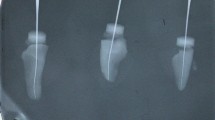Abstract
Objective
The aim of this study was to formulate a regression equation for calculating working lengths in primary molars using EAL (Root ZX and Ipex) for teeth with and without resorption and to evaluate, in vivo, the accuracy of the electronic apex locators in determining working lengths in primary teeth with and without resorption in comparison with Ingles radiographic method.
Study design
The study was a cross-over study. Fifty children undergoing pulpectomy in primary mandibular molars (total 150 root canals) with and without resorption were evaluated. The actual length of each root was measured with Ingles radiographic method followed by the use of two generations of apex locators. The distances were measured with radiographs, apex locators and working lengths tabulated. Frequency distribution of working length from radiographic apex and their percentages were calculated. Pearson’s correlation coefficient was used to assess the closeness of the measurements to radiographic apex with or without resorption followed by formulating regression equations.
Results
It was observed that 131 (87.33 %) of the 150 readings with Root ZX, and 122 (81.33 %) of the 150 readings with IPEX were within 0.0–1.0 mm of the radiographic readings. Root ZX gave 96.77 % (30) and IPEX gave 90.32 % (28) of 31 acceptable readings (within 0.0–1.0 mm of the radiographic apex) in resorption cases. Measurements with apex locator and radiographic methods were highly correlated.
Conclusion
Apex locators are reliable when compared with Ingles radiographic method and can enhance the safety of treatment in specific situations such as presence of root resorption. In case of non-availability of apex locators, the equations given in our study can be of use.




Similar content being viewed by others
References
Angwaravong O, Panitvisai P. Accuracy of an electronic apex locator in primary teeth with root resorption. Int Endod J. 2009;42:115–21.
Elayouti A. The ability of Root ZX apex locator to reduce the frequency of overestimated radiographic working length. J Endod. 2002;28(2):116–9.
Ghaemmaghami S, Eberle J, Duperon D. Evaluation of the Root ZX apex locator in primary teeth. Pediatr Dent. 2008;30:496–8.
Ingle J, Bakland L, Buchanan S, et al. Endodontic cavity preparation. 4th ed. Philadelphia: Williams & Wilkins; 1994. p. 92–227.
Ingle J, Himel T, Hawrish C, Bakland L. Cavity preparation. In: Ingle J, editor. Endodontics. 5th ed. Hamilton: Decker; 2002. p. 517–25.
Martinez MAL, Forner-Navarro L, Sanchez-Cortes JL, Llena-Puy C. Methodological considerations in the determination of working length. Int Endod J. 2001;34:371–6.
Mente J, Seidel J, Buchalla W, Koch MJ. Electronic determination of root canal length in primary teeth with and without root resorption. Int Endod J. 2002;35:447–52.
Neena IE, Ananthraj A, Praveen P, Karthik V, Rani P. Comparison of digital radiography and apex locator with the conventional method in root length determination of primary teeth. J Indian Soc Pedod Prev Dent. 2011;29:300–4.
Nelson-Filho P, Romualdo PC, Bonifacio KC et al. Accuracy of the ipex multi frequency electronic apex locator in primary molars: an exvivo study. Int Endod J. 2011;44:303–6.
Nguyen HQ, Kaufman AY, Komorowski RC, Friedman S. Electronic length measurement using small and large files in enlarged canals. Int Endod J. 1996;29:359–64.
Prattern DH, McDonald NJ. Comparison of radiographic and electronic working lengths. J Endod. 1996;22(4):173–6.
Riccucci D, Langeland K. Apical limit of root canal instrumentation & obturation, Part 2. A histological study. Int Endod J. 1998;31:394–409.
Saritha S, Uloopi KS, Vinay R, Sekhar RC, Rao VV. Clinical evaluation of Root ZX II electronic apex locator in primary teeth. Eur Arch Paediatr Dent 2012;13:32–35.
Stober EK, Duran Sindreu F, Mercade M et al. An evaluation of Root ZX and IPEX apex locators: an invivo study. J Endod. 2011;37(5):608–10.
Spangberg SF. Instruments, materials & devices. In: Cohen S, Burns RC, editors. Pathways of pulp. 8th ed. St. Louis: Mosby; 2002. p. 521–72.
Conflict of interest
The authors deny any conflicts of interest.
Author information
Authors and Affiliations
Corresponding author
Rights and permissions
About this article
Cite this article
Dandempally, A., Muppa, R., Duddu, M.K. et al. Formulating a regression equation for determination of working length in primary molars using apex locators: a clinical study. Eur Arch Paediatr Dent 14, 369–374 (2013). https://doi.org/10.1007/s40368-013-0011-1
Received:
Accepted:
Published:
Issue Date:
DOI: https://doi.org/10.1007/s40368-013-0011-1




